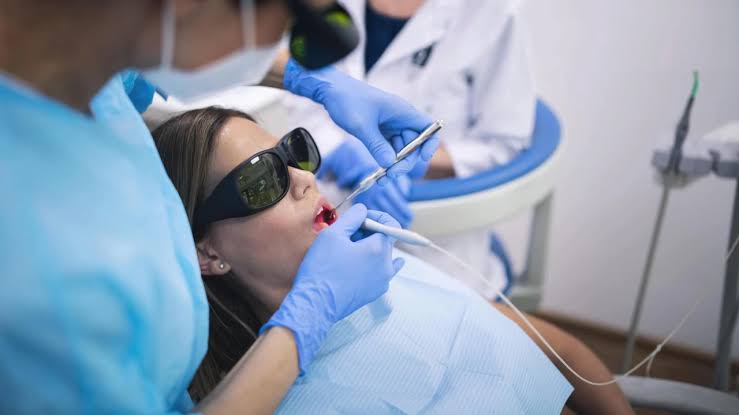If the word “laser” makes you think of sci-fi movies, it’s time to think again—lasers are transforming dental care in real, remarkable ways. From making procedures more comfortable to improving healing time, laser technology has revolutionized modern dentistry. Whether you’re anxious about dental visits or simply curious about new options, here’s why laser dentistry might be a reason to smile.
What Is Laser Dentistry?
Laser dentistry uses focused light beams (lasers) to perform a variety of dental procedures. These lasers can target soft tissues like gums or hard tissues like teeth, depending on the procedure. Unlike traditional tools like drills or scalpels, lasers offer precision, less discomfort, and often, faster healing.
Top Benefits of Laser Dentistry
1. Minimally Invasive & Painless
2. Faster Healing & Less Bleeding
3. Reduced Risk of Infection
4. More Precision, Less Damage
5. Improved Patient Experience
Common Dental Procedures Using Lasers
• Gum reshaping and contouring
Lasers are widely used in gum reshaping and contouring to safely and precisely remove excess gum tissue and sculpt the gum line. This minimally invasive technique enhances smile aesthetics, treats “gummy” smiles, and improves symmetry. Laser treatment causes less bleeding, reduces discomfort, shortens healing time, and minimizes the risk of infection.
• Treatment for gum disease
• Cavity detection and tooth preparation
Lasers assist in cavity detection by identifying early signs of tooth decay through fluorescence or light reflection, often revealing problems invisible to the naked eye or X-rays. In tooth preparation, lasers can remove decayed tissue with high precision, preserving more healthy tooth structure, reducing the need for anesthesia, and minimizing discomfort.
• Teeth whitening
Lasers are used in teeth whitening to accelerate the bleaching process and enhance results. A whitening gel is applied to the teeth, and a laser activates the gel, allowing it to penetrate the enamel more effectively. This method offers quicker, more noticeable results compared to traditional whitening, with minimal sensitivity.
• Biopsies or lesion removal
Lasers are used in dental biopsies and lesion removal to precisely excise abnormal tissue with minimal damage to surrounding areas. The laser’s high-energy light seals blood vessels as it cuts, reducing bleeding, swelling, and discomfort. It also sterilizes the area, lowering infection risk and promoting faster, cleaner healing.
• Frenectomy (for tongue-tie or lip-tie)
Laser-assisted frenectomy has become increasingly popular in dental and medical practices due to its numerous benefits over traditional scalpel-based techniques. Laser assisted surgery are minimally invasive , reduced bleeding , less pain and discomfort , faster healing and recovery , and lower risk of infection .
MYTHS VS. FACTS
#1Myth: Laser dentistry is painful.
Fact: Laser procedures are typically less painful than traditional methods. Many treatments require little or no anesthesia, and patients often report less post-operative discomfort.
#2Myth: Lasers can only be used for teeth whitening
Fact: While lasers are used in whitening, they also play a role in many other treatments—such as cavity removal, gum reshaping, treating gum disease, biopsies, and lesion removal.
#3Myth: Lasers can damage teeth or gums.
Fact: Dental lasers are precisely calibrated for safety and accuracy. When used by trained professionals, they target only the intended tissue, minimizing damage to surrounding areas.
#4Myth: Laser dentistry is experimental and not proven.
Fact: Laser technology has been used in dentistry for decades and is backed by scientific research and clinical success. It’s approved by dental associations and regulatory bodies worldwide.
#5Myth: Laser treatments are more expensive than traditional ones.
Fact: While some laser procedures may cost slightly more due to advanced technology, the benefits—like quicker healing and fewer follow-up visits—can make them more cost-effective in the long run.
CONCLUSION
Lasers are effectively used in the treatment of gum disease to remove infected tissue, kill bacteria, and promote healing without harming healthy gums. This minimally invasive approach reduces bleeding, swelling, and discomfort compared to traditional methods. It also supports tissue regeneration and helps preserve the teeth and supporting bone structure.
Lasers in dentistry are more than a high-tech trend—they’re a game-changing tool that brings comfort, precision, and faster healing to the dental chair. As technology continues to evolve, dental visits are becoming less invasive and more patient-friendly. The future of dentistry is bright—and it’s lit by lasers.

